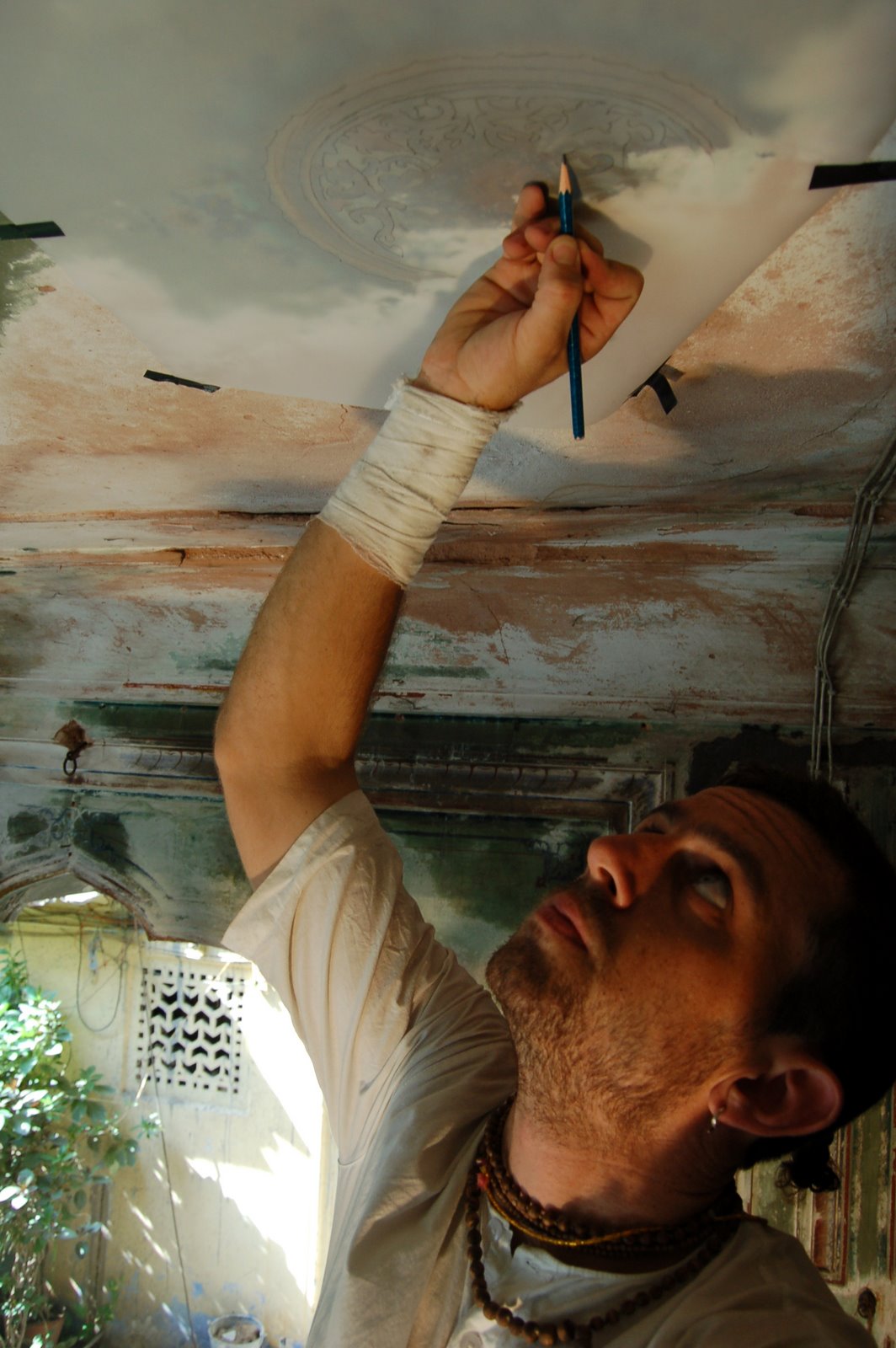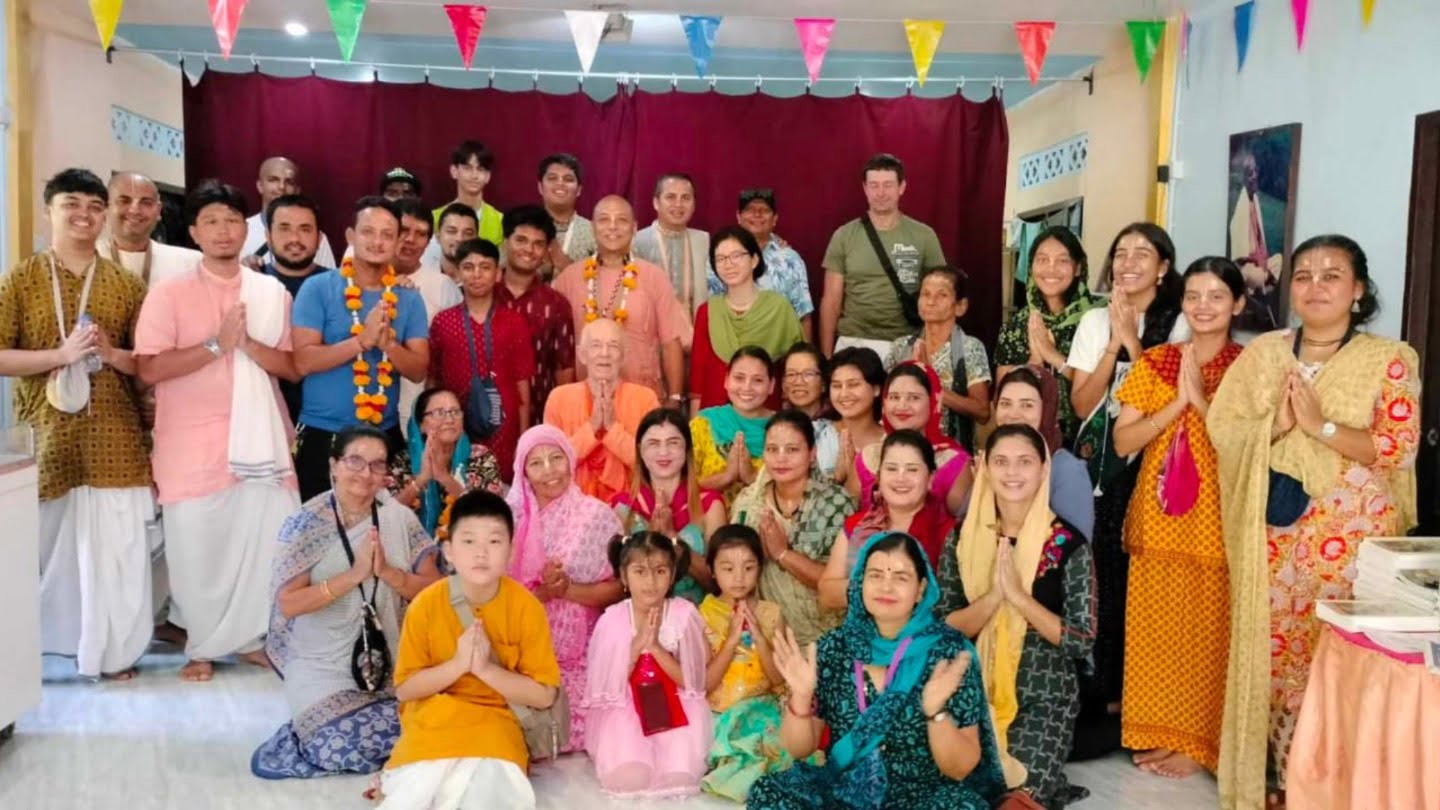Young Devotee Professional Restores Rajasthan Temples
By Madhava Smullen | Aug 07, 2010

A second-generation ISKCON devotee who worked as a professional art restorer in Los Angeles is on a mission to bring the ancient temples of Rajasthan back to their full glory.
His first project, begun earlier this year, is the home of Radha-Damodara—one of the many Deities originally installed by Gaudiya Vaishnava saints in Krishna’s birthplace of Vrindavana, and later given over to the care of Jaipur kings when Muslims invaded Vrindavana in 1670.
Born into a family of artists, 29-year-old Kuvaleshaya Dasa called the acclaimed muralist, fresco painter, and sculptor Bernard Zakheim “grandfather.” His father Nara-Narayan Dasa, meanwhile, was the art director of the Bhaktivedanta Book Trust from 1975 to 1980, and has run his own successful art restoration business, Nathan Zakheim Associates, since 1974.
Nara-Narayan’s expertise proved invaluable to the young Kuva, who opted to learn his craft as his father’s apprentice—often restoring BBT paintings—rather than going to college.
Later, working for his father’s business, Kuva began to receive major contracts from local municipalities, including a three-year project for the City of Los Angeles, restoring and relocating eleven murals that were painted along its freeways.
In 2008, Kuva established his own company, Zakheim Art Conservation. There, he continued to land prestigious projects, such as the relocation of twelve murals by celebrated British street artist Banksy from an art loft in downtown Los Angeles to the living room of a private collector.
Kuva explains the skill involved: “They were painted on a brick wall,” he says. “So we replicated the wall’s texture and created a fiberglass replica of it, then remounted only the paint layer onto the replica wall, so that it was transportable.”
But Kuva found that the more successful he became, the more he lost touch with what really mattered to him: his spiritual life.

“I was spending all my time meeting and trying to impress superficial people in the LA art scene, pursuing name and fame, and trying be a part of something that thought it was deep but was really meaningless and profane,” he says. “I thought, ‘How did this happen? I used to make the turbans for Lord Jagannath. I used to help decorate the temple for festivals. And now I have no time for that.’”
Then, in 2009, it all fell apart. The economy crashed, and the City of Los Angeles was in a crisis. Employees were fired, funding for projects cut.
In a more introspective mood, Kuva began eating his lunch at the New Dwaraka ISKCON temple. Seeing so many devotees who had been consistently engaged in service to Krishna for as long as he could remember, he began to think: “I wish I was like them—so steady and dedicated.”
Days later, he got a phone call from the management at ISKCON’s Krishna Balarama Mandir in Vrindavana, asking him if he could finish a restoration project he’d begun on ten Krishna paintings in 2008. He took it as a sign from the Lord, and flew to India to finish the service.
But Krishna’s plan for Kuva had only just begun. While in Vrindavana, he made friends with ISKCON Coventry, UK temple president Haridas, who invited him to
take a day-trip to Jaipur. There, the two were hosted by a wealthy businessman, who took them to visit the city’s temples, including Radha-Damodara Mandir.
“The Deities there are beautiful—Radha-Damodara themselves were carved by the Vaishnava saint Srila Rupa Goswami and given to his contemporary Jiva Goswami to worship; and Radha-Vrindavana Chandra were the personal Deities of Chaitanya Charitamrita author Krishna Dasa Kaviraja,” Kuva says.
“But it was very difficult for me to properly concentrate on them. Over the years, my eyes have been trained to see the defects in artwork, and as I looked at all the beautiful decorations and fresco paintings on every surface of the temple, I saw that many were run-down, broken, or missing. What’s more, someone had begun painting over the elaborate original artwork with very simple, crude lines in an effort to fix things—which had instead resulted in even worse damage.”

So when the businessman turned to Kuva and said, “Aren’t the Deities beautiful?” he replied honestly, “I must admit that I am have a hard time concentrating on them because of all the temple’s damaged artwork—restoration is my area of training.”
Promptly, the businessman said, “If you stay here in Jaipur, and restore this temple as service, I’ll pay for all the materials you’ll need.”
“It was so ironic,” Kuva says. “I’d just been praying to Krishna for some service, saying that I was sick of running my art restoration business; that my life had been ruined by bad association and aspirations for material fame. Of course, with his dry humor, Krishna said, ‘Fine—you don’t want to do art restoration as a business? Then do it as service!”
Kuva agreed to the proposal. His first step was to tell a local Jaipur friend he’d known from the US, explaining that he’d like to meet someone who could give him the history of the temple and connect him with artisans—perhaps a curator or conservator of the City Palace Museum.
“In true Indian-style, it was like, ‘Oh yes, my cousin-brother knows this person,’ and they knew someone else, who knew someone else,” Kuva recalls. “It seemed sure to be a big, dragged-out process where I would end up not having found what I was looking for but having met everyone’s family members.”
He was wrong. Through what he calls “a series of divinely-inspired miscommunications,” Kuva suddenly found himself meeting with the Princess of Jaipur herself, Diya Kumari.
“Once I had gotten over my initial nervousness—do I curtsey? No, that’s what girls do… how on earth do you greet a princess?—I described the project to her,” he says. “Within a short time, she had connected me with all the technical experts and artisans who have since proven so invaluable.”
Encouraged, Kuva set to work.
“There are three significant types of art at Radha-Damodara,” he explains. “First, there are wall frescos—called fresco secco—made with lime plaster and painted with fresh pigments. Then there are decorative features on walls and pillars made with a highly polished lime plaster with a glossy smooth finish that replicates the appearance of marble. And finally, there is mirror work made with little squares of convex mirror that create a nice texture and glow.”
All of these had been damaged. Some had been scratched, or blackened with soot from ghee lamps. The plaster was a particular problem—the leaky roof had let water in, which had run down through the plaster, taking huge chunks of it off. “Also, not unlike our ISKCON temples, nails had been driven straight into the plaster to decorate for festivals without consideration of the outcome to the artwork,” says Kuva. “And when they were pulled out, they’d pulled a whole plug of plaster out with them and left bullet holes everywhere.”

In fact, some features were so damaged that only part of them were visible—a problem Kuva fixed by making tracings of the remaining artwork to replicate the rest. He also hired some of the last remaining artisans expert in the type of plasterwork that was common 300 years ago.
“Our lead artisan, Laddhu Ram, is 83 years old, began his craft as a child, and has worked under the last ruling Maharaja of Jodhpur, Sawai Man Singh II,” Kuva says. “It’s been an amazing privilege to be able to observe such a master at work.”
Other elements of the restoration, such as repainting, have yielded some challenges. Top-level artists are required for such a painting job, while the materials are costly too—in India, raw materials must be purchased at a market, and must be manually ground into a pigment. What’s more, some pigments that were very common at the time the temple was built are now very rare and expensive.
Still, Kuva hopes to finish the work within a year. “When it’s completed, the original artwork features will be cleaned and devoid of scratches and missing portions,” he says. “It will look beautiful and fresh, while retaining a patina of time to preserve its history and antiquity.”
But Kuva won’t stop at the Radha Damodara temple. Next, he plans to restore Radha-Gopinath Mandir, with ISKCON guru Indradyumna Swami paying for a small monument which will house the tulasi beads worn by Vaishnava saint Madhu Pandit Goswami, as well as the original arati paraphernalia that he used to worship Radha-Gopinath.
Kuva has also already begun smaller restoration projects in ancient village temples throughout Rajasthan.
“Recently I went to one village where they had a Radha Krishna temple that was 400 years old,” he says. “It was in total disrepair, so we gathered the whole village together to help us put fresh cow dung on the floor, paint the walls with limewash, and fix the roof. I polished and repainted the Deities, and we organized the community to commit to offering food, holding kirtan, and having worship services there at least once daily. It was a wonderful project. I hope to continue with more, and to invite more devotees to join me in going village to village.”

Kuva hopes that the restoration work will see Jaipur’s temples—which play a significant part in its history—become more integrated into the city’s tourism, and give a sense of the culture and history of Bhakti to foreign tourists who have come to India looking for something exotic and profound.
The work will also introduce foreigners only familiar with ISKCON as an American phenomenon to its deep roots and heritage, as well as giving devotees who both joined and grew up in ISKCON a sense of the illustrious ancient lineage they are part of.
Yet while all these are important goals, Kuva has an even more urgent message behind his efforts.
“The splendor of our spiritual cultural heritage is rapidly getting lost, and if we don’t do something now, there may be a generation soon who won’t be able to see the physical places of pilgrimage written about in Vaishnava literature,” says Kuva. “As India continues to modernize, trying to copy the West, it’s blindly covering over what had Westerners attracted to it in the first place.”
He hopes that when they see westerners restoring their temples and holy places, Indians will realize that they are stewards of an international treasure, something that’s of value and interest to people all over the world.
“Already, the Rajasthani government has a strong sense of their Vaishnava culture and a deep appreciation for it,” says Kuva. “They’re such a pleasure to work with. Let’s hope that the rest of India follows suite.”
To find out more about assisting Kuva’s project through documenting it with photography or video, building a website for it, funding it, or overseeing artistic restoration, please contact kuva108@gmail.com.














